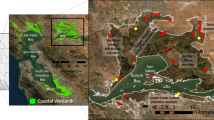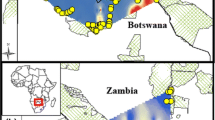Abstract
Habitat fragmentation can exacerbate the impacts on population persistence in species with rapid life histories and specialized habitat requirements. We investigated genetic structuring across the range of the federally endangered (USA) Perdido Key beach mouse (PKBM), Peromyscus polionotus trissyllepsis, using 16 microsatellite loci. Between 2010 and 2012 we sampled the three core habitat areas that are separated by 3–5 km of developed area. One location GSP was re-established in 2010 with a release of 48 captive bred mice. The other two parks had a reticulate recent history, including extirpations, translocations and, a recent (2009) natural re-colonization. Our objectives were to document the level of genetic drift associated with the post-release phase at GSP over a 2-year period, and to test the hypothesis that PKBM dispersal connectivity is restricted between the three parks. The three populations were significantly genetically differentiated in 2010 and 2012 (pairwise F ST ranged from 0.135 to 0.276). However, Bayesian clustering, assignment tests and hybridization analyses revealed inter-park dispersal and reproduction in 2012 that was absent in 2010. The detection of dispersal was an important step in understanding the regulation of connectivity in this fragmented system. We propose that a combination of recent apparent population increases across the island combined with the concurrent re-establishment of beachfront vegetated sand berms encouraged inter-park dispersal detected in 2012. These results provide important information for the future conservation of beach mice inhabiting northern Gulf of Mexico and Atlantic barrier islands in light of continued development pressure.







Similar content being viewed by others
References
Anderson EC, Thompson EA (2002) A model-based method for identifying species hybrids using multilocus genetic data. Genetics 160:1217–1229
Andrén H (1996) Population response to habitat fragmentation: statistical power and the random sample hypothesis. Oikos 76:235–242
Bowen WW (1968) Variation and evolution of Gulf Coast populations of beach mice (Peromyscus polionotus). Bull Fla State Mus Biol Sci 12:1–91
Brown JH, Kodric-Brown A (1977) Turnover rates in insular biogeography: effect of immigration on extinction. Ecology 58:445–449
Bryant D, Rodenburg E, Cox T, Nielsen D (1995) Coastlines and risk: An index of potential development-related threats to coastal ecosystems. World Resources Institute, Washington DC
Burgman MA, Lindenmayer DB, Elith J (2005) Managing landscapes for conservation under uncertainty. Ecology 86:2007–2017
Calabrese JM, Fagan W (2004) A comparison-shopper’s guide to connectivity metrics. Front Ecol Environ 2:529–536
Chirhart SE, Honeycutt RL, Greenbaum IF (2000) Microsatellite markers for the deer mouse Peromyscus maniculatus. Mol Ecol 9:1661–1686
Domingues VS, Poh Y-P, Peterson BK, Pennings PS, Jensen JD, Hoekstra HE (2012) Evidence of adaptation from ancestral variation in young populations of beach mice. Evolution 66:3209–3223
Evanno G, Regnaut S, Goudet J (2005) Detecting the number of clusters of individuals using the software structure: a simulation study. Mol Ecol 14:2611–2620
Fahrig L (2003) Effects of habitat fragmentation on biodiversity. Ann Rev Ecol Syst 34:487–515
Fischer J, Lindenmayer DB (2007) Landscape modification and habitat fragmentation: a synthesis. Glob Ecol Biogeogr 16:265–280
Goudet J (2001) FSTAT, a program to estimate and test gene diversities and fixation indices (version 2.9.3). http://www2.unil.ch/popgen/softwares/fstat.htm. Accessed 24 Oct 2012
Hardy OJ, Vekemans X (2002) SPAGeDi: a versatile computer program to analyse spatial genetic structure at the individual or population levels. Mol Ecol Notes 2:618–620
Holler NR, Mason DW, Dawson RM, Simons T, Wooten MC (1989) Reestablishment of the Perdido Key beach mouse (Peromyscus polionotus trissyllepsis) on Gulf Islands National Seashore. Conserv Biol 3:397–404
Holliman DC (1983) Status and habitat of Gulf Coast Alabama beach mice Peromyscus polionotus ammobates and P.p. trissyllepsis. Northeast Gulf Sci 6:121–129
Humphrey SR (1992) Rare and endangered biota of Florida. Vol. 1: mammals. University Press of Florida, Gainesville
Humphrey SR, Barbour DB (1981) Status of three subspecies of Peromyscus polionotus in Florida. J Mammal 62:840–844
Hunter ML, Hutchinson A (1994) The virtues and shortcomings of parochialism: conserving species that are locally rare, but globally common. Conserv Biol 8:1163–1165
Irwin J, Smith A, Gore JA, Greene DU, Austin JD (2012) Whole-genome amplification of microsatellites reveals limited genetic variation in a captive colony relative to the wild source population of the endangered beach mouse, Peromyscus polionotus trissyllepsis. Fla Sci 75:253–258
Jombart T, Devillard S, Dufour A-B, Pontier D (2008) Revealing cryptic spatial patterns in genetic variability by a new multivariate method. Heredity 101:92–103
Jost L (2008) GST and its relatives do not measure differentiation. Mol Ecol 17:4015–4026
Knutson TR, McBride JL, Chan J, Emanuel K, Holland G, Landsea C, Held I, Kossin JP, Srivastava AK, Sugi M (2010) Tropical cyclones and climate change. Nat Geosci 3:157–163
Lacy RC, Alaks G, Walsh A (1996) Heirarchical analysis of inbreeding depression in Peromyscus polionotus. Evolution 50:2187–2200
Lande R (1999) Extinction risks from anthropogenic, ecological, and genetic factors. In: Landweber LF, Dobson AP (eds) Genetics and the extinction of species. Princeton University Press, Princeton, pp 1–22
Lynn WJ (2000) Social organization and burrow site selection of the Alabama beach mouse (Peromyscus polionotus ammobates) M.S. thesis, Auburn University, Alabama
Lynn WJ (2001) Perdido Key area-GINS status survey trapping and translocation summary. Final report march 7. US Fish and Wildlife Service, Panama City
Madsen T, Ujvari B, Olsson M (2004) Novel genes continue to enhance population growth in adders (Vipera berus). Biol Conserv 120(1):145–147
Manel S, Gaggiotti OE, Waples RS (2005) Assignment methods: matching biological questions with appropriate techniques. Trends Ecol Evol 20:136–142
McPeek MA, Holt RD (1992) The evolution of dispersal in spatially and temporally varying environments. Am Nat 140:1010–1027
Moritz C (2002) Strategies to protect biological diversity and the evolutionary processes that sustain it. Syst Biol 51:238–254
Mullen LM, Hirschmann RJ, Prince KL, Glenn TC, Dewey MJ, Hoekstra HE (2006) Sixty polymorphic microsatellite markers for the oldfield mouse developed in Peromyscus polionotus and Peromyscus maniculatus. Mol Ecol Notes 6:36–40
Nei M (1978) Estimation of average heterozygosity and genetic distance from a small number of individuals. Genetics 89:583–590
Oli MK, Holler NH, Wooten MC (2001) Viability analysis of Gulf Coast beach mice (Peromyscus polionotus) populations. Biol Conserv 97:107–118
Paetkau D, Slade R, Burden M, Estoup A (2004) Genetic assignment methods for the direct, real-time estimation of migration rate: a simulation-based exploration of accuracy and power. Mol Ecol 13:55–65
Peakall R, Smouse PE (2006) GenAlEx 6: genetic analysis in excel. Population genetic software for teaching and research. Mol Ecol Notes 6:288–295
Pérez I, Anadón JD, Díaz M, Nicola GG, Tella JL, Giménez A (2012) What is wrong with current translocations? A review and decision-making proposal. Front Ecol Environ 10:494–501
Piry S, Alapetite A, Cornuet J-M, Paetkau D, Baudouin L, Estoup A (2004) GENECLASS2: a software for genetic assignment and first-generation migrant detection. J Hered 95:536–539
Pritchard JK, Stephens M, Donnelly P (2000) Inference of population structure using multilocus genotype data. Genetics 155:945–959
Provancha JA, Oddy DM (1992) A mark and release study of the southeastern beach mouse (Peromyscus polionotis niveiventris) on the Kennedy Space Center. Fla Sci 55(Supplement 1):28
Queller DC, Goodnight KF (1989) Estimating relatedness using genetic markers. Evolution 43:258–275
Rannala B, Mountain JL (1997) Detecting immigration by using multilocus genotypes. Proc Natl Acad Sci USA 94:9197–9201
Rousset F (2008) Genepop’007: a complete reimplementation of the Genepop software for Windows and Linux. Mol Ecol Resour 8:103–106
Saunders DA, Hobbs RJ, Margules CR (1991) Biological consequences of ecosystem fragmentation. Conserv Biol 5:18–32
Smith MH (1968) Dispersal of the oldfield mouse, Peromyscus polionotus. Bull Ga Acad Sci 26:45–51
Sumner FB (1926) An analysis of geographic variation in mice of the Peromyscus polionotus group from Florida and Alabama. J Mammal 7:149–184
Trakhtenbrot A, Nathan R, Perry G, Richardson DM (2005) The importance of long distance dispersal in biodiversity conservation. Diver Distrib 11:173–181
United States Fish and Wildlife Service (USFWS) (1985) Endangered and threatened wildlife and plants; determination of endangered status and critical habitat for three beach mice; final rule. Fed Reg 50:23872–23889
United States Fish and Wildlife Service (USFWS) (2006) Endangered and threatened wildlife and plants; Designation of critical habitat for the Perdido Key beach mouse, Choctawhatchee beach mouse, and St. Andrew beach mouse. Fed Regist 71:60238–60370
United States Fish and Wildlife Service (USFWS) (1987) Recovery plan for the Alabama beach mouse (Peromyscus polionotus ammobates) Perdido Key beach mouse (P. p. trisyllepsis) and Choctawhatchee beach mouse (P. p. allophrys). USFWS, Atlant
Vähä JP, Primmer CR (2006) Efficiency of model-based Bayesian methods for detecting hybrid individuals under different hybridization scenarios and with different number of loci. Mol Ecol 15:63–72
Weber JN, Peters MB, Tsyusko OV, Linnen CR, Hagen C, Schable NA, Tuberville TD, McKee AM, Lance SL, Jones KL, Fisher HS, Dewey MJ, Hoekstra HE, Glenn TC (2010) Five hundred microsatellite loci for Peromyscus. Conser Genet 11:1243–1246
Weir BS, Cockerham CC (1984) Estimating F-statistics for the analysis of population structure. Evolution 38:1358–1370
Acknowledgments
We thank V. Domingues (Harvard), K. Russell (Santa Fe Zoo), T. Frampton (Brevard Zoo) and S. Allard (Palm Beach Zoo) for providing tissues samples. A large number of people participated in the sampling effort, including T. Day, E. Evans, C. Frosch, A. Harvey, R. Hoggard, M. Gillikin, J. Hargrove, M. Keith, C. Martin, M. Mayo, A. Smith, M. Tucker, C. Winchester, and many others.
Author information
Authors and Affiliations
Corresponding author
Electronic supplementary material
Below is the link to the electronic supplementary material.
Rights and permissions
About this article
Cite this article
Austin, J.D., Gore, J.A., Greene, D.U. et al. Conspicuous genetic structure belies recent dispersal in an endangered beach mouse (Peromyscus polionotus trissyllepsis). Conserv Genet 16, 915–928 (2015). https://doi.org/10.1007/s10592-015-0710-8
Received:
Accepted:
Published:
Issue Date:
DOI: https://doi.org/10.1007/s10592-015-0710-8




